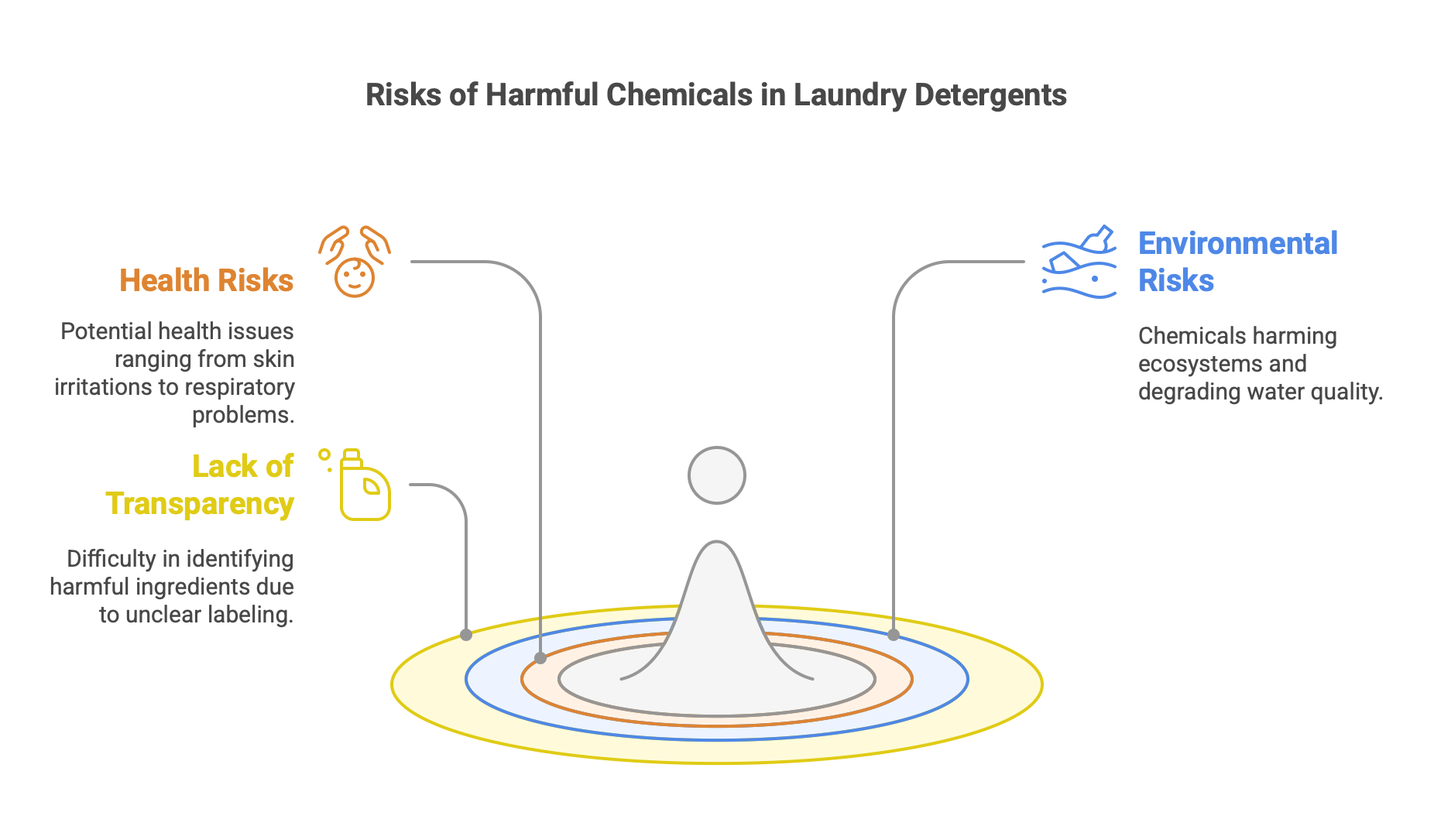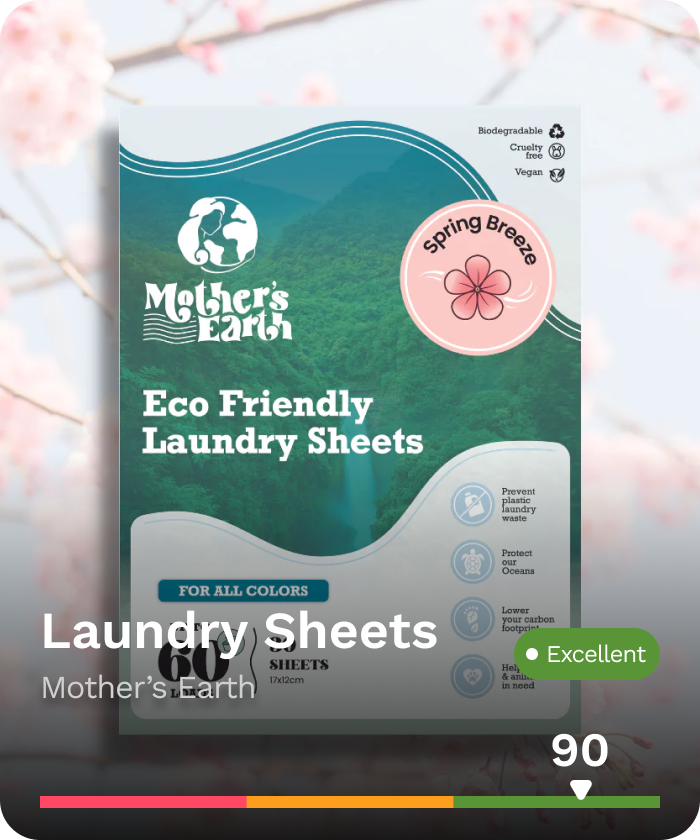TL;DR
Chemical Composition of Laundry Detergents: Allergens and Irritants
Laundry detergents often contain chemicals like fragrances, preservatives, and dyes that can trigger allergic reactions and skin irritations, such as contact dermatitis. Common symptoms include redness, itching, and swelling, especially in areas frequently in contact with clothing. Fragrances are particularly sensitizing, and preservatives and antibacterials may also contribute to allergic responses. To reduce risks, opting for fragrance-free and dye-free detergents is recommended. Severe reactions should be addressed by consulting a healthcare provider for effective solutions and preventive measures.
Health and Environmental Risks of Laundry Detergents
Many laundry detergents contain harmful chemicals that pose both health and environmental risks. Health issues range from skin irritation to respiratory concerns caused by carcinogens released by scented detergents. Phosphates and other chemicals can contribute to health problems and environmental damage. These substances often pollute ecosystems, leading to water contamination and harm to wildlife. Chemicals like nonylphenol ethoxylates and phthalates persist in the environment, accumulating in animals and entering the food chain. Consumers are encouraged to choose safer, more transparent detergent options to protect both personal health and the planet.
Potential Health Risks of Laundry Detergents: Skin Reactions and Allergies
Exposure to chemicals in laundry detergents can cause skin-related issues, such as contact dermatitis, resulting in red, itchy rashes, bumps, and blisters. The rash often appears in areas where clothing is tight, like armpits and behind the knees. Allergic reactions can develop suddenly, even with long-term use, due to allergens like fragrances, preservatives, and dyes. High chemical concentrations in detergents can lead to skin irritation, making fragrance- and dye-free options ideal for those with sensitivities or allergies. Choosing gentler products helps prevent adverse skin reactions.
Water Pollution and Ecological Risks
Laundry detergents contribute to water pollution, primarily through phosphates, synthetic fragrances, and non-biodegradable ingredients. Phosphates, when released into aquatic environments, cause eutrophication, harming ecosystems and depleting oxygen. Synthetic musk fragrances disrupt microbial communities, affecting water quality and aquatic life. Additionally, slow-degrading surfactants like LAS and hazardous chemicals such as nonylphenol accumulate in water bodies, posing long-term ecological risks. To mitigate these effects, using biodegradable, eco-friendly detergents is crucial for protecting water quality and aquatic organisms.
Safe Usage and Eco-Friendly Alternatives for Laundry Detergents
To reduce health and environmental risks, consumers should choose eco-friendly laundry detergents that avoid harmful chemicals like 1-4 dioxane. Look for biodegradable, plant-based ingredients that break down naturally. Eco-friendly options like water-free detergent sheets, concentrated liquids, and plastic-free packaging offer effective cleaning while minimizing waste. Prioritize products with sustainable ingredients and packaging for a gentler, healthier laundry routine that benefits both your skin and the planet.
Chemical Composition of Laundry Detergents
Allergens and Irritants
Laundry detergents contain a variety of chemicals that, while effective at cleaning,
can pose significant risks as allergens and irritants. These adverse reactions can
result from repeated exposure to ingredients such as fragrances, preservatives, dyes,
and other chemicals commonly found in many detergent formulations[9][11].
Contact dermatitis, a common skin condition triggered by direct exposure to an
allergen or irritant, is one notable concern[8][10]. This condition presents as a red,
itchy rash and can develop in areas where the skin comes into frequent contact with
washed clothing, such as the armpits and groin[9][10]. The symptoms of a laundry
detergent allergy may include hot skin, swelling, blisters, or bumps, and can appear
suddenly even if one has been using the same detergent brand for years[11].
Fragrances are often added to laundry detergents to provide a fresh scent but
are highly sensitizing and can lead to allergic reactions in some individuals[8][12].
Preservatives and antibacterials, which prevent liquids from spoiling, as well as
substances added to thicken, color, or lubricate the product, are other common
allergens[12]. These chemicals can be found in a variety of household items, from
cleaners to personal care products, and their continued use can trigger allergic
contact dermatitis[12][13].
Identifying and mitigating the effects of laundry detergent rashes involve recognizing
the symptoms and opting for fragrance-free and dye-free detergents to reduce
exposure to potential allergens[9]. In cases of severe or persistent reactions, con-
sulting a healthcare provider is advisable to explore suitable remedies and preventive
measures[10].

ALVA Veriefied products ✅
When you make a purchase through retailer links on our site, we may earn commission through affiliate programs. All affiliate fees ALVA receives support our mission. Learn more here
Are your products safe?
Scan your products now with the ALVA app to get a personalised risk analysis.
Health and Environmental Risks
Laundry detergents are a ubiquitous household product, yet many contain a variety of
harmful chemicals that pose significant health and environmental risks. These risks
are often overlooked by consumers, who may not be aware of the potential dangers
lurking in their laundry products[1][2].
Health risks associated with the chemicals in laundry detergents are diverse and
can range from minor skin irritations to more severe health issues. For instance,
scented laundry detergents have been found to emit hazardous chemicals, including
carcinogens, which can spread throughout the home via dryer vents, potentially
leading to respiratory issues and long-term health concerns[3]. Phosphates, com-
monly used in detergents, can also contribute to skin irritation and other health
problems[4][5]. Additionally, the lack of transparency regarding ingredient lists on
detergent packaging makes it difficult for consumers to identify and avoid these
harmful substances[6].
Environmental risks are equally concerning. When these chemicals wash down
the drain, they do not simply disappear; they enter ecosystems, where they can
harm wildlife and degrade water quality[2]. Phosphates, for example, can lead to
eutrophication in aquatic environments, causing excessive growth of algae that
depletes oxygen in the water and harms aquatic life[5]. Moreover, many synthetic
ingredients in detergents, such as nonylphenol ethoxylates and phthalates, are not
biodegradable and can persist in the environment, accumulating in the tissues of
wildlife and potentially entering the food chain[6][7].
In light of these risks, it is crucial to be informed about the ingredients in laundry
detergents and to seek out safer alternatives that protect both health and the envi-
ronment[1][2]. By making conscious choices, consumers can contribute to a cleaner,
healthier home and planet.
Potential Health Risks
Exposure to chemicals present in laundry detergents can lead to various health
risks, particularly skin-related issues. One of the most common problems is contact
dermatitis, a condition that results in a red, itchy rash. This rash can be widespread or
confined to specific areas such as the armpits and groin, and may appear as bumps,
hives, or blisters[25][27][29].
Laundry detergent rashes typically manifest as red, scaly, and itchy skin, often in
areas where clothing is tight, like behind the knees or underarms[28]. Symptoms
can also include hot skin and swelling, with the severity and spread of the rash
varying from person to person[27][29]. Allergic reactions to laundry detergents can
develop suddenly, even if the individual has used the same brand for years, due to
the presence of allergens such as fragrances, preservatives, and dyes[25][26].
The high concentration of chemicals in laundry detergents, which helps to remove
stubborn stains, can sometimes do more harm than good, leading to adverse skin re-
actions[26]. People with sensitivities or allergies to these chemicals may experience
discomfort and skin irritation, highlighting the importance of choosing fragrance- and
dye-free detergents to prevent such issues[25].
Environmental Impact
Water Pollution
Phosphates
Phosphorus, similar to nitrogen, is an essential nutrient required for all life forms.
The most common form of phosphorus utilized by biological organisms is phosphate
(PO4), which plays crucial roles in the formation of DNA, cellular energy production,
and the composition of cell membranes and plant cell walls[22]. In the context of
laundry detergents, phosphates are often included due to their ability to soften water
and enhance cleaning efficiency.
However, the presence of phosphates in aquatic environments, primarily due to runoff
from household detergents, can lead to significant ecological impacts. Phosphates
naturally occur in water bodies, but their levels can vary based on environmental
factors such as rainfall and fertilizer runoff[23]. When the concentration of phosphates
becomes excessive, it can result in the water becoming polluted with a murky
green overcast, which negatively affects water clarity and the health of aquatic
organisms[23].
One of the primary outcomes of elevated phosphate levels is the rapid growth of
aquatic weeds, which can disrupt the balance of the ecosystem[23]. Additionally,
the phenomenon of cultural eutrophication occurs when excess nutrients, including
phosphorus, accelerate aquatic plant growth. This human-caused process leads to
increased biomass production within water bodies, causing harmful shifts in biolog-
ical communities, fish kills, and a reduction in dissolved oxygen and pH levels[24].
Sources of these human-induced phosphorus inputs include wastewater treatment
facilities, lawn fertilizers, stormwater runoff, and agricultural practices[24]. Reducing
phosphorus levels in water bodies is crucial for maintaining water quality and the
health of aquatic life.
Synthetic Fragrances
Synthetic musk fragrances are ubiquitous in the environment, being detected in
various compartments such as air, water, and soil[20][21]. Their presence in water
systems is particularly concerning due to their resistance to biodegradation and
propensity to accumulate in aquatic ecosystems[21]. These compounds enter water
bodies primarily through human wastewater and can be traced in lake sediments,
indicating a long-term historical input[21].
The impact of synthetic musk fragrances on aquatic life is subtle but significant.
Research suggests that these compounds may disrupt microbial communities in
biofilms, which play a crucial role in maintaining water quality by breaking down
organic pollutants and cycling nutrients[20]. The alteration of microbial communities
can affect the overall health of aquatic ecosystems, potentially leading to the prolif-
eration of harmful bacteria and the decline of beneficial species[20].
Furthermore, synthetic musks have been found in the fat tissues of mammals, raising
concerns about their bioaccumulative properties and the potential for long-term
ecological and health effects[21]. While the full extent of their impact on aquatic
organisms and water quality remains under investigation, there is enough evidence to
warrant the consideration of sustainable alternatives to these persistent compounds-
[21].
Biodegradability
Biodegradability of laundry detergents is a crucial factor in assessing their environ-
mental impact. Many conventional detergents contain chemicals that do not fully
biodegrade, leading to the contamination of water supplies, rivers, and oceans with
toxic substances such as heavy metals, including cadmium and arsenic[1]. This lack
of complete biodegradation can lead to the accumulation of these toxic substances in
aquatic ecosystems, causing significant harm to marine life and potentially entering
human food chains.
Surfactants, which are the primary cleaning agents in detergents, present a notable
challenge. For instance, Linear Alkylbenzene Sulfonates (LAS), commonly used
surfactants, degrade slowly and are petroleum-based. These compounds can be
toxic to aquatic organisms, particularly when they accumulate in water bodies[1]. The
slow degradation rate of LAS surfactants increases their potential to harm aquatic
environments over the long term.
Phosphates, another common ingredient in detergents, exacerbate water pollution
problems. They can inhibit the biodegradation of organic substances, making it
difficult for wastewater treatment facilities to eliminate them effectively[3]. High con-
centrations of phosphates can lead to eutrophication, a process where water bodies
become overly enriched with nutrients, leading to excessive algal blooms. These
blooms can deplete oxygen levels in the water, causing the death of fish and other
aquatic organisms[2].
Furthermore, hazardous chemicals like nonylphenol, found in some detergents, pose
serious environmental and health risks due to their persistence and tendency to
bioaccumulate. Nonylphenol has been detected in human breast milk, blood, and
urine, and it is associated with adverse reproductive and developmental effects in
animals[4]. This chemical’s persistence in the environment highlights the importance
of finding safer alternatives.
Given these issues, there is a growing emphasis on the development and use
of environmentally friendly detergents that minimize these harmful impacts. Such
alternatives can significantly reduce the long-term environmental damage caused by
conventional laundry detergents, aiding in the protection of both aquatic ecosystems
and human health.
Safe Usage and Alternatives
When it comes to ensuring the safe usage of laundry detergents, it is crucial for
consumers to be vigilant about the products they choose. One significant concern
is the presence of potentially harmful chemicals in conventional laundry detergents,
which can pose risks to both health and the environment. For instance, Tide has been
banned in Europe due to its high levels of 1-4 dioxane, a chemical linked to various
health issues[14].
To mitigate these risks, consumers can opt for eco-friendly laundry detergents, which
are designed to be safer alternatives. However, the lack of specific criteria for what
constitutes “eco-friendly,” “green,” or “natural” can make it challenging to identify
genuinely safe products[15]. Expert recommendations suggest looking for detergents
with biodegradable, plant-based ingredients that break down naturally and do not
leave behind harmful chemicals[18].
In recent years, there has been a significant advancement in the formulations
of eco-friendly detergents, with innovations such as water-free detergent sheets,
concentrated liquids, and plastic-free packaging. These products not only perform
effectively in cleaning clothes but also reduce environmental impact by minimizing
plastic waste[16]. Choosing detergents with sustainable packaging and earth-friendly
ingredients ensures that the product is gentler on both the skin and the planet[17].
Extensive testing and evaluations of various eco-friendly laundry detergents have
shown that they can effectively remove stains and odors while maintaining afford-
ability and incorporating a higher percentage of plant-based ingredients[19]. By
prioritizing these eco-friendly alternatives, consumers can enjoy a cleaner laundry
routine that aligns with their health and environmental values.
Verification of Safety and Environmental Claims
In the crowded market of laundry detergents, verifying the safety and environmental
claims made by brands is essential for consumers. One effective way to ensure
the credibility of these claims is by looking for certifications. Certifications like those
provided by trusted organizations can help confirm whether a product is genuinely
natural or organic, cutting through the noise of misleading marketing[30].
Key characteristics of safe laundry detergents include the use of natural, hypoal-
lergenic ingredients, and being free of synthetic fragrances, dyes, and harmful
chemicals. Additionally, a low level of 1,4-dioxane, below 2ppm, is a good indicator of
a safer product[31]. Earth Breeze Eco Sheets, for instance, are recognized for their
non-toxic, hypoallergenic, and biodegradable formula, making them one of the safest
choices available[31].
Proper handling and storage of laundry detergents are also crucial to ensuring
safety. The American Cleaning Institute advises that while detergents are generally
safe when used as directed, they can pose significant health risks if misused.
Essential precautions include wearing protective gear, washing hands thoroughly
after use, and keeping products out of reach of children[32]. Such measures not only
protect users from health issues like skin irritation and respiratory problems but also
prevent potential environmental damage caused by improper disposal of detergent
ingredients[32].
In the United States, the regulatory framework for laundry detergents is robust, aimed
at ensuring consumer safety, environmental protection, and truthful marketing. Key
regulations include the Federal Hazardous Substances Act (FHSA), which provides
guidelines on labeling and handling potentially hazardous chemicals in consumer
products[33]. By understanding and adhering to these regulations, both manufactur-
ers and consumers can make more informed decisions about the products they use.
Reading labels carefully and avoiding harsh chemicals like phosphates, chlorine, and
parabens are practical steps consumers can take to verify the safety and environ-
mental friendliness of laundry detergents[34]. Engaging in comparative testing and
experiments, as part of educational initiatives, can further help consumers evaluate
the efficacy and environmental impact of various detergents. These activities promote
a hands-on understanding of how different products perform and the truthfulness of
their marketing claims[36].
References:
[1]: 13 Chemicals in Laundry Detergent & How to Avoid Them!
[2]: Understanding the Dangers of Laundry Detergents: What to Avoid
[3]: 7 Common Toxins Found in Laundry Detergent – ECOS®
[4]: Is Laundry Detergent Toxic and Which Toxins Are in It? – Caring Consumer
[5]: Harmful Chemicals In Laundry Detergents – Rinse
[6]: 11 Harmful Ingredients Found in Laundry Detergent – Molly’s Suds
[7]: 11 Harmful Ingredients In Your Laundry Detergent & How You Can Avoid …
[8]: How to Tell If You’re Allergic to Your Laundry Detergent
[9]: How to Identify and Treat a Laundry Detergent Rash – Healthline
[10]: Laundry Detergent Rash: 7 Ways to Treat It – Oh So Spotless
[11]: Laundry Detergent Allergy: Causes, Symptoms, and Prevention
[12]: Chemical Allergies: Shampoo, Cleaners, and More – WebMD
[13]: Skin Rash from Cleaning Products? Likely One of These Common Irritants
[14]: 9 Best Truly Natural and Non Toxic Laundry Detergents
[15]: 12 Best Eco-Friendly Laundry Detergents | NBC Select – NBC News
[16]: 8 Best Eco-Friendly Laundry Detergents of 2024 – Good Housekeeping
[17]: 15 Most Eco Friendly Laundry Detergents Of 2025
[18]: Discover the Most Eco-Friendly Laundry Detergent: Tips to Choose …
[19]: 9 Best Eco-Friendly Laundry Detergents of 2025 – Reviewed
[20]: Synthetic Musk Fragrances in Water Systems and Their Impact on … – MDPI
[21]: Environmental Sources, Occurrence, and Effects of Synthetic Musk Fragrances
[22]: Indicators: Phosphorus – US EPA
[23]: Effects of High Phosphate Levels in Water – Healthy Ponds
[24]: Aquatic Life Impacts of Phosphorus Research – CT.gov
[25]: How to Identify and Treat a Laundry Detergent Rash – Healthline
[26]: How to Tell If You’re Allergic to Your Laundry Detergent
[27]: Laundry Detergent Allergy: Causes, Symptoms, and Prevention
[28]: Laundry Detergent Rash: 7 Ways to Treat It – Oh So Spotless
[29]: What Does A Rash Look Like From Laundry Detergent? | Skin Sensitivities …
[30]: Are There Any Certifications To Look For When Purchasing Organic Liquid …
[31]: The 12 Safest Laundry Detergents That Actually Work (2024)
[32]: Laundry Detergent Safety Tips | ClothesLyne
[33]: U.S. Regulations for Laundry Detergents – Dell Tech
[34]: Safest Laundry Detergent: Tips For Choosing Family-friendly, Eco …
[35]: Laundry Detergent Regulations: Canada vs. U.S. | Dell Tech
[36]: How Clean Is Clean? Testing Detergents and Analyzing Product Claims
[37]: Some Laundry Chemicals and Their Effects on the Environment.
[38]: Forget Detergents, Simply Washing Clothes is Bad for Our Oceans
[39]: Chemical Water Pollution Caused By Every Day Detergents
[40]: How our detergent footprint is polluting aquatic ecosystems – Down To Earth
Are your products save?
Download ALVA to check if the products you use regularly are free from dangerous chemicals.

